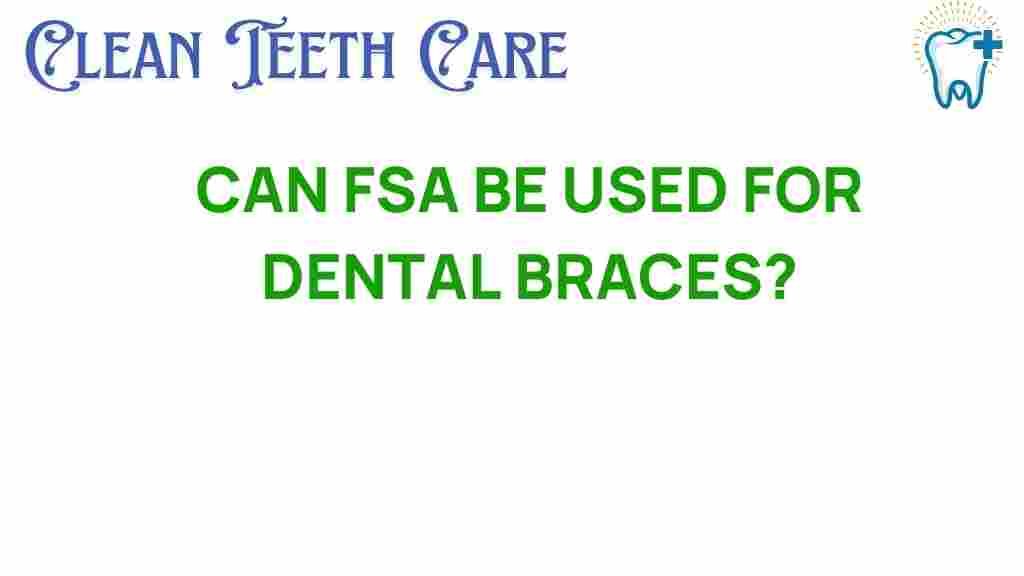Unlocking the Secrets: Can FSA Be Used for Dental Braces?
When it comes to managing healthcare costs, understanding your options can make a significant difference in your financial planning. One common question many people have is whether they can use a Flexible Spending Account (FSA) for dental braces. In this article, we will explore the relationship between FSAs and orthodontics, and how you can leverage your flexible spending account to cover the costs of dental care, including braces.
What is an FSA?
A Flexible Spending Account (FSA) is a tax-advantaged financial account that can be set up through your employer. It allows you to set aside pre-tax dollars to pay for eligible medical expenses. This can include healthcare costs that are not covered by your insurance, such as co-pays, deductibles, and other out-of-pocket expenses.
Understanding Dental Braces and Orthodontics
Dental braces are orthodontic devices used to straighten teeth and correct bite issues. They are an essential part of orthodontics, which is the branch of dentistry that deals with diagnosing and correcting misaligned teeth and jaws. Orthodontic treatment can be a significant financial burden, making it crucial to understand how to manage these expenses effectively.
Can You Use FSA for Dental Braces?
Yes, you can use your FSA to pay for dental braces, but there are specific guidelines to keep in mind:
- Braces must be deemed medically necessary by a dental professional.
- Orthodontic expenses must be incurred within the FSA plan year.
- You should keep all receipts and documentation for claims.
Step-by-Step Process to Use FSA for Dental Braces
Using your FSA to pay for dental braces involves several steps. Here’s how to go about it:
Step 1: Consult with Your Orthodontist
Schedule a consultation with an orthodontist to discuss your or your child’s need for braces. During this appointment, the orthodontist will evaluate dental health and provide a treatment plan, including the cost of braces.
Step 2: Get Documentation
Once you have a treatment plan, ask your orthodontist for a written statement that outlines:
- The diagnosis and medical necessity for braces.
- The total cost of the orthodontic treatment.
- The expected duration of treatment.
Step 3: Check Your FSA Plan
Review your FSA plan details. Not all plans are the same, so it’s vital to understand the specific rules regarding eligible expenses. Contact your HR department or FSA administrator if you have any questions.
Step 4: Submit Claims
When you start your orthodontic treatment, keep all invoices and receipts. Submit your claims to the FSA for reimbursement. Make sure to include:
- Proof of payment (receipts).
- The documentation provided by your orthodontist.
Step 5: Keep Records
Maintain thorough records of all transactions and communications related to your FSA claims. This will help in case of any discrepancies or audits.
What to Do If Your Claim Is Denied
Sometimes, claims may be denied due to various reasons. Here are some troubleshooting tips:
- Check for Errors: Review your claim submission for any mistakes, such as incorrect information or missing documentation.
- Contact Your FSA Administrator: Reach out to your FSA administrator for clarification on why your claim was denied. They can provide guidance on how to resolve the issue.
- Submit an Appeal: If you believe the denial was unjust, you can appeal the decision. Follow the specific appeal process outlined by your FSA plan.
Benefits of Using FSA for Dental Braces
Utilizing your FSA for dental braces can provide several financial benefits:
- Tax Savings: Contributions to an FSA are made with pre-tax dollars, reducing your taxable income.
- Budgeting for Expenses: Setting aside funds for orthodontic treatment helps you plan your budget more effectively.
- Reduced Out-of-Pocket Costs: Using FSA funds can significantly lower your out-of-pocket costs for braces.
Alternative Options for Financing Dental Braces
If you find that the costs of dental braces are still overwhelming, consider these alternative financing options:
- Payment Plans: Many orthodontists offer payment plans that allow you to spread the cost of braces over time.
- Insurance Coverage: Check if your dental insurance covers orthodontic treatment. Some plans may offer partial coverage for braces.
- Health Savings Account (HSA): If you have an HSA, you can use those funds for orthodontic expenses as well.
Conclusion
Using a Flexible Spending Account (FSA) for dental braces can be a smart financial move, allowing you to save on taxes and manage your medical expenses more effectively. By following the outlined steps and understanding the requirements, you can unlock the potential of your FSA to cover orthodontic treatment. Remember to keep thorough records and communicate with your orthodontist and FSA administrator to ensure a smooth process.
For more information on managing healthcare expenses, visit this helpful resource. If you’re considering options for orthodontic treatment, consult your orthodontist to explore all available financial avenues.
In summary, incorporating your FSA into your financial planning for dental braces can ease the burden of unexpected medical expenses while ensuring that you receive the necessary orthodontic care.
This article is in the category Treatments and created by CleanTeethCare Team
